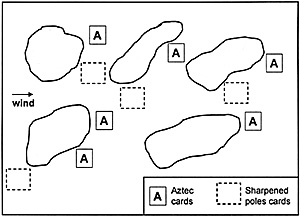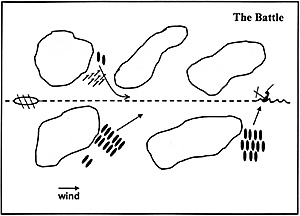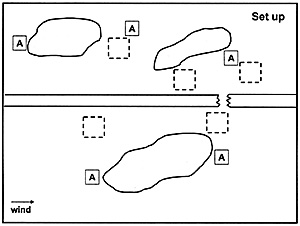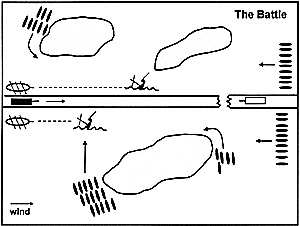 Here are two sample games based on scenarios similar to historic battles. The first is a boat vs. boat ambush game. The second is a coordinated land and water battle. There are, of course, a variety of other possibilities.
Here are two sample games based on scenarios similar to historic battles. The first is a boat vs. boat ambush game. The second is a coordinated land and water battle. There are, of course, a variety of other possibilities.
Scenario 1: The Ambush
The Aztecs have laid an ambush for the Spanish. A single canoe will lead the Spanish boat to a site prepared for the ambush. The Aztecs have placed sharpened poles in some channels and hidden canoes behind islands of reeds. They will attack when seen or when others become engaged. The Spanish boat will pursue the canoe until attacked, then react as seems appropriate. The Aztec goal is to overturn and capture the Spanish boat and its crew. The Spanish goal is to get out alive.
 In setting up the game board, I first laid out a group of reed islands, represented by cardboard sheets with colored pencil scribbles. I prepared seven cards with the following numbers on them to represent lurking Aztec canoes:
In setting up the game board, I first laid out a group of reed islands, represented by cardboard sheets with colored pencil scribbles. I prepared seven cards with the following numbers on them to represent lurking Aztec canoes:
- Card 1: 3 x D-6
Card 2: 5 x D-6
Card 3: 1 x D-6
Card 4: 2 x D-6
Card 5: 1 x D-6
Card 6: No canoes
Card 7: No canoes
I positioned five of these face down in likely places. They would be turned up and replaced by canoes as the Spanish became able to see them. I also prepared five cards to represent areas with sharpened stakes. Two of the five were blank. I positioned four cards on the board. The resulting battle ran as follows.
The Aztecs did a poor job of planning the ambush. They only put sharpened stakes in one area and it was off to the side. The Spanish boat never went near it. The canoe acting as bait led the Spanish between two lines of islands. The Spanish were closing in and firing. The first ambush force was too small, only two canoes, and too far to the left to be effective. The second force was larger, but too far away on the right. About when these were spotted, the Spanish boat hit and sank the bait canoe with cannon fire. They could easily outrun the pursuing canoes, but the attackers scored a few hits with spears.
The Spanish were about to sail out into open water when a force of 12 canoes charged from behind the last island on the right and hit them on the side. The Spanish boat was tipped over and the surviving crew members were captured. They were taken off to be sacrificed.
 Scenario 2: The Causeway
Scenario 2: The Causeway
The Spanish are making a major push down the causeway supported by a brig on each side and allied Indians. The Aztecs have torn out a bridge creating a gap in the causeway. They have forces defending the gap and have canoes hiding behind rush islands. They have also placed sharpened stakes in strategic areas.
Most of the set-up involved random positioning of islands, canoes, and sharpened stakes as in the earlier scenario. I also diced to see if the Spanish had a cannon on the causeway. They failed the die roll, a 6 on a D-6. I also used my gunpowder rule, an ace means an explosion. I used phased movement. I dealt out six playing cards to determine order of movement and firing during a turn. The six units were Spanish land forces, Aztec land forces, Spanish boats on their right, Aztec boats on their right, Spanish boats on the left and Aztec boats on the left. In effect I had three separate, but interrelated fights going on; one on the causeway and one on each side. I diced for morale or movement by the Spanish forces and the Aztec canoes. The battle was surprising.
 The Aztecs stood behind the gap created by the destruction of the bridge. They had large numbers of canoes on both flanks. They also had stakes and canoes hidden in ambush. The Spanish advanced boldly down the causeway as their boats sailed forward. The brig on the right quickly got in trouble. It was caught on sharp stakes with fifteen Aztec canoes closing in. The Spanish land forces advanced and fired to support the trapped boat but did only minor damage to the Aztec canoes.
The Aztecs stood behind the gap created by the destruction of the bridge. They had large numbers of canoes on both flanks. They also had stakes and canoes hidden in ambush. The Spanish advanced boldly down the causeway as their boats sailed forward. The brig on the right quickly got in trouble. It was caught on sharp stakes with fifteen Aztec canoes closing in. The Spanish land forces advanced and fired to support the trapped boat but did only minor damage to the Aztec canoes.
On the Spanish left, the brig advanced but was being pursued by Aztec canoes. There was a great roar and a cloud of smoke as the brig on the right exploded. The Aztec canoes ignored the smoke and Spanish land forces as they advanced and tipped over the brig and took the survivors prisoners. On the Spanish left, the other brig sailed into the advancing mass of Aztec canoes whiled trailed by others. It failed to hit or sink any canoes and was soon tipped over. The crews of the two brigs were soon on their way to the altars of the Aztec gods. The Spanish land forces were outflanked on both sides and retreated.
These scenarios are only a limited sample of the possibilities. You might want to change the relative strengths of the two sides. You could add allied Indian canoes to the Spanish side or have the Spanish ambush the Aztecs out among the reed islands. You could add a cannon to the Spanish land forces or even use horsemen.
As I considered the questions of fighting battles on land and water, it occurred to me that there are several others in different eras. Consider a few examples: Salamis, Bunker Hill, Vicksburg, New Orleans (1815), Normandy (1944), and all those Pacific Islands in World War II. Consider the possibilities.
More Conquest of Mexico 1521
Back to Table of Contents -- Lone Warrior #133
Back to Lone Warrior List of Issues
Back to MagWeb Magazine List
© Copyright 2001 by Solo Wargamers Association.
This article appears in MagWeb (Magazine Web) on the Internet World Wide Web.
Other military history articles and gaming articles are available at http://www.magweb.com
